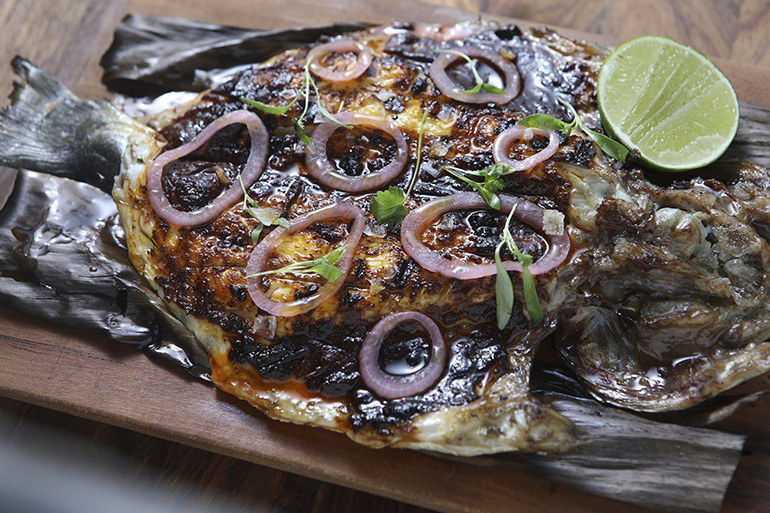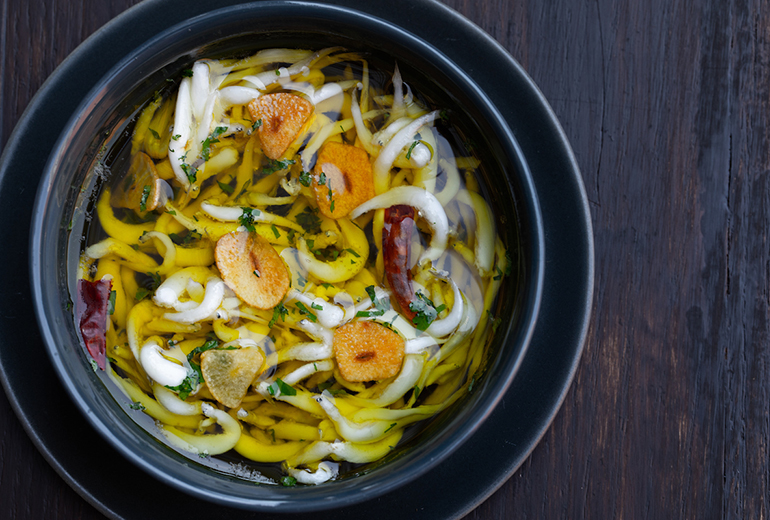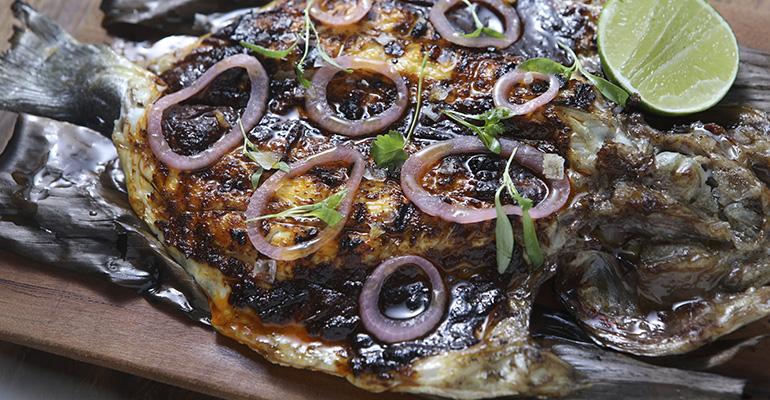Global cuisines and flavors continue to brighten up menus, adding bold, flavorful touches to dishes in a growing number of menu categories. Seafood is among the most recent category to experience the influence of global flavors, as more chefs take inspiration from countries near and far to add interest and excitement to familiar fish and seafood.
“I draw inspiration from all over the globe and have developed a great appreciation for the way different cultures incorporate seafood into their cuisine,” said chef Andrew Zimmerman of Proxi in Chicago.
The menu at Proxi, which reads like a trip around the world, includes seasonal whole fish with a tomato-tamarind masala and green mango salad inspired by coastal Indian cooking from Goa and Kerala; a grilled swordfish informed by Japanese yakitori-style food, skewered and cooked over charcoal and served with shishito peppers, Saikyo miso, and yuzu kosho; and a grilled octopus with mole verde and charred squash, that serves as an ode to Mexican cuisine.

Coastal Indian cooking shines in this whole fish dish with a tomato-tamarind masala at Proxi in Chicago.
Also taking a broad worldview when cooking is Junghyun Park, executive chef and owner of Atoboy, a family-style Korean concept in New York City.
“When I design dishes and cook, I am not only inspired by Korean cuisine, but by multiple cuisines,” said Park.
At Atoboy, Park serves an octopus dish made with mango, mojo verde and fermented dubu, which is a good example of his multi-cultural approach.
“[The octopus dish] achieves its balance from the fermented tofu originating from Chinese cuisine, mojo verde which is a Canarian green sauce, and it also utilizes other ethnic ingredients such as sumac and mango,” Park said.
At Lapeer Seafood Market, a restaurant and bar serving coastal cuisine in Alpharetta, Ga., executive chef Blake Hartley draws inspiration from coastal regions around the globe that use fresh seafood, most recently Vietnam.
“Vietnam has been inspiring us by the fresh flavors and condiments they use,” said Hartley. “Their proximity to the China Sea gives them access to an abundance of fresh seafood, which you see throughout Vietnamese cooking.”
Currently Hartley is serving whole fish with nuoc cham, chile, basil and potato chips. Nuoc cham is a traditional Vietnamese dipping sauce typically made with fish sauce, citrus, a sweetener, chiles and herbs. For his version, Hartley uses local chiles and agave nectar as a sweetener for the sauce, which he says “complements our large selection of mezcal beautifully."
Spanish and Japanese flavors and techniques meld at Bar Ramone, a tapas restaurant in Chicago.

Spanish and Japanese cuisines meld in this Ice Fish dish at Bar Ramone.
“In Spain, a lot of chefs are using Japanese ingredients because the cuisines and techniques match up so well,” said Bar Ramone chef Alex Trim.
The restaurant’s Japanese Ice Fish is a play on traditional Spanish angulas (baby eel) with Japanese ingredients. The dish features Japanese Ice Fish, or shirauo, which some describe as like a little anchovy, that is simmered in garlic oil, shiro dashi and brandy, and then finished with crispy garlic, arbol chile and parsley.
“[The dish] incorporates chef and partner Hisanobu Osaka’s Japanese background and influence,” said Trim. “It resulted in a perfect fusion between the two cultures.”
Chef Lauro Romero brings a global approach to American seafood classics at Portland’s King Tide Fish & Shell. For example, Romero seasons grilled Oregon rock fish or shrimp for use in lunch-time tacos with a house-made rub he calls “Mexican Togarashi.” Togarashi, or shichimi, is a Japanese spice mix with such ingredients as red chile pepper, sansho (Japanese pepper), orange peel, sesame seed, ginger, nori and poppy seed.
“I love the citrus element and balance that shichimi has, but wanted something a little less spicy,” said Romero. “So I created my own version with dry smoked chiles to bring in Mexican flavors.”
Romero also makes a peanut morita salsa for a Hamachi crudo tostada and clam escabeche toasts, both using classic Mexican flavors and techniques.





